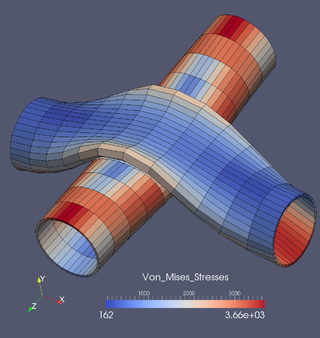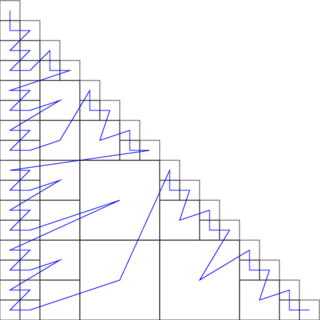
Video CD is a home video format and the first format for distributing films on standard 120 mm (4.7 in) optical discs. The format was widely adopted in Southeast Asia, South Asia, East Asia, Central Asia and the Middle East, superseding the VHS and Betamax systems in the regions until DVD-Video finally became affordable in the first decade of the 21st century.

Dot matrix printing, sometimes called impact matrix printing, is a computer printing process in which ink is applied to a surface using a relatively low-resolution dot matrix for layout. Dot matrix printers are a type of impact printer that prints using a fixed number of pins or wires and typically use a print head that moves back and forth or in an up-and-down motion on the page and prints by impact, striking an ink-soaked cloth ribbon against the paper. They were also known as serial dot matrix printers. Unlike typewriters or line printers that use a similar print mechanism, a dot matrix printer can print arbitrary patterns and not just specific characters.
Quattro Pro is a spreadsheet program developed by Borland and now sold by Corel, most often as part of Corel's WordPerfect Office suite.

Quadraphonic sound – equivalent to what is now called 4.0 surround sound – uses four audio channels in which speakers are positioned at the four corners of a listening space. The system allows for the reproduction of sound signals that are independent of one another.
In graph theory and computer science, an adjacency matrix is a square matrix used to represent a finite graph. The elements of the matrix indicate whether pairs of vertices are adjacent or not in the graph.

In numerical analysis and scientific computing, a sparse matrix or sparse array is a matrix in which most of the elements are zero. There is no strict definition regarding the proportion of zero-value elements for a matrix to qualify as sparse but a common criterion is that the number of non-zero elements is roughly equal to the number of rows or columns. By contrast, if most of the elements are non-zero, the matrix is considered dense. The number of zero-valued elements divided by the total number of elements is sometimes referred to as the sparsity of the matrix.
In mathematics, particularly matrix theory, a band matrix or banded matrix is a sparse matrix whose non-zero entries are confined to a diagonal band, comprising the main diagonal and zero or more diagonals on either side.

In computer science, a sparse file is a type of computer file that attempts to use file system space more efficiently when the file itself is partially empty. This is achieved by writing brief information (metadata) representing the empty blocks to the data storage media instead of the actual "empty" space which makes up the block, thus consuming less storage space. The full block size is written to the media as the actual size only when the block contains "real" (non-empty) data.
A frontal solver is an approach to solving sparse linear systems which is used extensively in finite element analysis. Algorithms of this kind are variants of Gauss elimination that automatically avoids a large number of operations involving zero terms due to the fact that the matrix is only sparse. The development of frontal solvers is usually considered as dating back to work by Bruce Irons.

In scientific computing, skyline matrix storage, or SKS, or a variable band matrix storage, or envelope storage scheme is a form of a sparse matrix storage format matrix that reduces the storage requirement of a matrix more than banded storage. In banded storage, all entries within a fixed distance from the diagonal are stored. In column-oriented skyline storage, only the entries from the first nonzero entry to the last nonzero entry in each column are stored. There is also row oriented skyline storage, and, for symmetric matrices, only one triangle is usually stored.

Iain S. Duff is a British mathematician and computer scientist, known for his work in numerical methods and software for solving problem with sparse matrices, in particular the Harwell Subroutine Library. From 1986 to 2009, he was the Group Leader of Numerical Analysis at Harwell Laboratory, which has moved in 1990 to the Rutherford Appleton Laboratory. He is also the Project Leader for the Parallel Algorithms Group at CERFACS in Toulouse.

Lis is a scalable parallel software library for solving discretized linear equations and eigenvalue problems that mainly arise in the numerical solution of partial differential equations by using iterative methods. Although it is designed for parallel computers, the library can be used without being conscious of parallel processing.
HSL, originally the Harwell Subroutine Library, is a collection of Fortran 77 and 95 codes that address core problems in numerical analysis. It is primarily developed by the Numerical Analysis Group at the Rutherford Appleton Laboratory with contributions from other experts in the field.
VMDK is a file format that describes containers for virtual hard disk drives to be used in virtual machines like VMware Workstation or VirtualBox.
The Matrix Market exchange formats are a set of human readable, ASCII-based file formats designed to facilitate the exchange of matrix data. The file formats were designed and adopted for the Matrix Market, a NIST repository for test data for use in comparative studies of algorithms for numerical linear algebra.
UMFPACK is a set of routines for solving unsymmetric sparse linear systems of the form Ax=b, using the Unsymmetric MultiFrontal method. Written in ANSI/ISO C and interfaces with
Matrix Toolkit Java (MTJ) is an open-source Java software library for performing numerical linear algebra. The library contains a full set of standard linear algebra operations for dense matrices based on BLAS and LAPACK code. Partial set of sparse operations is provided through the Templates project. The library can be configured to run as a pure Java library or use BLAS machine-optimized code through the Java Native Interface.

GetFEM++ is a generic finite element C++ library with interfaces for Python, Matlab and Scilab. It aims at providing finite element methods and elementary matrix computations for solving linear and non-linear problems numerically. Its flexibility in choosing among different finite element approximations and numerical integration methods is one of its distinguishing characteristics.

librsb is an open-source parallel library for sparse matrix computations using the Recursive Sparse Blocks (RSB) matrix format.









